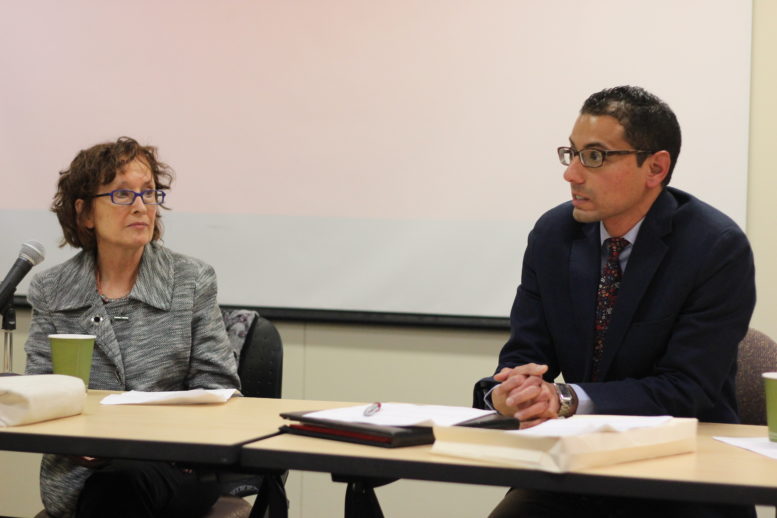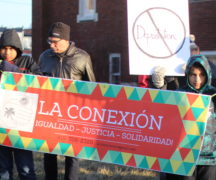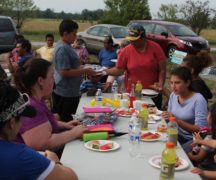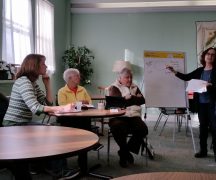By DAVID DUPONT
BG Independent News
The immigration debate is about more than walls. It’s about families trapped by laws and borders that separate them.
Eugenio Mollo, Jr., managing attorney with ABLE has those difficult conversations.
A father of three, here without documents, telling him his mother is dying in Mexico. If he goes to see her, he’s at risk of not be able to return to his wife and American-born children.
What can he do?
Mollo can explain the law, but he has no good answer to give him.
The client loves his family in America and yet the law poses the choice of being separated from them or comforting his mother in her dying days.
He asks: What kind of heartless system is this?
This is the system we have, and it is a system that has become more unforgiving since Donald Trump has moved into the White House, Mollo said.
Mollo and Beatriz Maya, director general of La Conexion de Wood County, took part on a panel Developing Strategies to Mobilize Our Communities as part of STRELLA: 7th Annual Conference of Student Research on Latino/A/X and Latin American Studies.
“The current climate has created an environment of fear and alarm in the community,” Maya said. “The greatest challenge we are facing in organizing the community is the fact that the community is absolutely terrified.”
The Trump Administration plans to add 10,000 new border agents, and to double to 80,000 the number of people it incarcerates for immigration problems.
Work place raids have increased, she said. None have occurred in Wood County, though a raid in Montpelier staged to find an individual netted eight people.
People are apprehended after traffic stops.
La Conexion’s efforts to get members of the immigrant community more engaged in public life are no dormant, since people wish to stay under the radar.
Instead, she said, the group is working with people to plan for the possibility that a family member, maybe a parent with children, is deported.
Of those considered undocumented, 66 percent have been here for 10 or more years. They have homes and children, Maya said.
La Conexion is organizing an Immigration Solidarity Committee. “We think that people who are non-immigrants are now in a safer position to advocate on behalf of the immigrant community,” Maya said. “The solidarity work is very crucial.”
She said a similar effort on campus is also planned.
Maya said La Conexion is also working with the city and local law enforcement to put safeguards in place for the undocumented immigrants.
Mollo said in discussing these people he prefers the term “undocumentable” instead of “undocumented.”
He said his job at ABLE – Advocates for Basic Legal Equality – involves in part helping people to climb the ladder to citizenship.
Naturalization should be the goal for immigrants. That gives them full membership in civic society, including the vote and the right to run from office as well as freedom from the fear of being deported. That’s not true of green card holders or those with visas.
That ladder, however, is broken he said.
Current law puts undocumentable immigrants in a position where they cannot legalize their status without opening themselves up to being deported.
People are under the impression that undocumentable immigrants could attain legal status if they “just got up early enough and waited in line long enough,” Mollo said. “But that line just doesn’t exist for many, many undocumentable people.”
He estimated there are as many as 11 million such residents of the country.
Maya said the greatest influx came after the passage of the North American Free Trade Agreement in 1994. The trade agreement disrupted the livelihood of many small farmers in Mexico, she said, sending them north to seek work.
Two years after NAFTA, Congress increased the penalties for those who are in the country without documents. Now they would be deported and couldn’t even apply to return to the U.S. for as long as 10 years. The goal was to encourage them to seek legal status.
“It didn’t work,” Mollo said.” It kept people with undocumentable status is the U.S.”
Mollo noted that in the mid-20th century the nation regularly updated its immigration laws. But we are now operating under a 1952 statute. Comprehensive immigration law reform is overdue, he said.
Instead the current administration is planning to build a wall.
Luis Moreno, a BGSU faculty member, said he grew up along the border. Fences already exist in many parts and have since 1848 when the land was annexed to the United States in the wake of the Mexican-American War.
It will be impossible for environmental reasons to erect barriers in other areas, he said. That $2 billion would be better spent on education and other government programs now on the chopping block.





